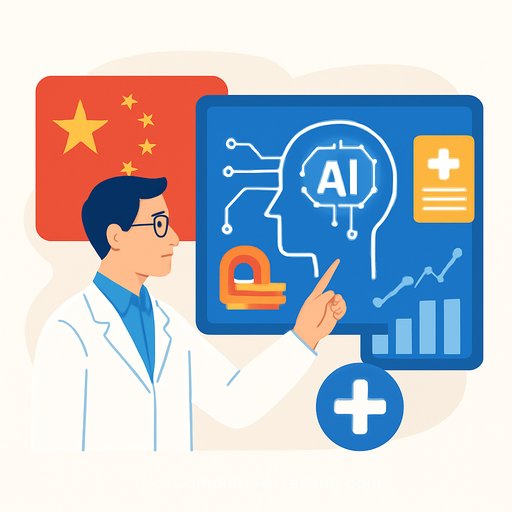China leads AI research output for medical devices: what healthcare leaders should do next
A new white paper reports that from 2020 to 2024, the global medical device field saw about 363,000 AI-related publications. China tops the list with 81,066 publications focused on AI applications in devices, signaling strong momentum across clinical and engineering domains.
The report, led by the National Innovation Center for Advanced Medical Devices and released in Guangzhou during an international exhibition, positions AI as a core driver of the shift from experience-based practice to data-driven, precision care. It also aims to convert more research into deployable products that improve public health across care settings.
Where AI is being applied in medical devices
- Assisted diagnosis and clinical decision support
- Medical imaging analysis and triage
- Disease prediction and risk stratification
- Surgical planning and intraoperative guidance
- Personalized treatment pathways
- Chronic disease monitoring and management
How China's focus differs
While many European and US programs prioritize cardiovascular interventional devices, Chinese research shows distinct strengths in materials science and oncology-related technologies.
- Nanoparticles for cancer treatment and drug delivery
- Flexible sensors for improved human-machine interaction
- Hydrogels for wound healing and tissue repair
Why this matters for healthcare decision-makers
- Pipeline visibility: Expect faster iteration from academic labs to clinical pilots, especially in imaging, oncology, and sensor-driven monitoring.
- Clinical value: AI can reduce variability, speed interpretation, and personalize care plans when paired with sound clinical governance.
- Procurement and partnerships: China's volume of publications suggests a growing pool of collaborators and vendors. Diligence should assess data quality, validation cohorts, and integration readiness.
- Regulatory readiness: Track evolving guidance on AI/ML-enabled devices to shorten approval timelines and avoid rework. See the FDA's AI/ML SaMD resources.
- Governance and ethics: Build safeguards around bias, explainability, and oversight. WHO's guidance on AI for health is a helpful reference: Ethics and governance of AI for health.
Practical next steps for hospitals and device companies
- Map 3-5 high-yield use cases (e.g., imaging triage, oncology response prediction, wound assessment) and define success metrics tied to outcomes and cost.
- Run time-boxed pilots with real-world data, clear guardrails, and a sunset or scale decision after 90-120 days.
- Stand up data and MLOps basics: data quality checks, versioning, monitoring for drift, and clear escalation paths.
- Align early with regulators and ethics boards on validation design, post-market monitoring, and human oversight.
- Build cross-functional teams (clinical, biomedical engineering, IT, quality, procurement) to speed selection and deployment.
Noted voices from the white paper
Leaders at the National Innovation Center for Advanced Medical Devices emphasize that AI is moving medical devices toward data-driven decision-making and precision care. The white paper is intended to guide government, industry, academia, healthcare, and investors, and to accelerate the conversion of research into solutions that benefit patients.
What to watch next
- Translation from publications to approved products and clinical guidelines
- Cross-border validation studies and interoperability with hospital IT
- Standards for AI evaluation, from datasets to real-world performance
- Reimbursement models that reward measurable clinical and operational gains
If you're building internal capability around AI in imaging, oncology, or clinical operations, structured training can shorten the learning curve. Explore role-based options here: AI courses by job.
Your membership also unlocks:






